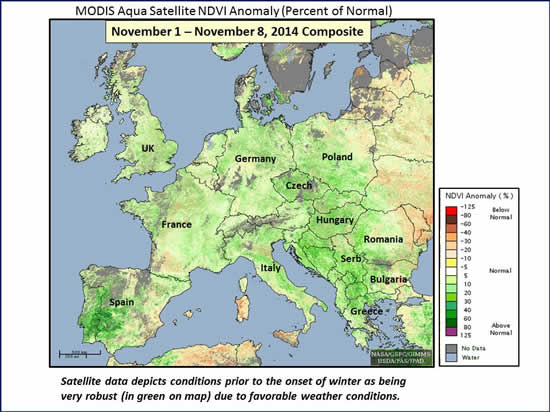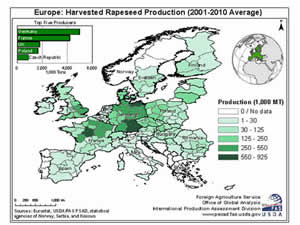EU 2015/16 Winter Crops in Good Shape Despite Some Regional Weather Issues
Mild Conditions

Development of autumn sown grains and oilseeds were assisted by warm fall temperatures and a mild start to winter. Most areas in Europe also received above-average precipitation during this time, benefitting plant emergence and development. These weather conditions created a rapid and extended period of early growth for winter crops, with reports indicating that crops had an extra two to three weeks of development compared to normal. The satellite image above shows European vegetation prior to dormancy as being much more robust than is typical.
While a dense autumn vegetation canopy is an indicator of healthy crops, it can also be risky for plants. Increased plant biomass prior to winter leaves plants more susceptible to cold or “smothering” underneath heavy snowfall. As of mid-January 2015 however, little snow has fallen during the course of the season and rainfall has been the predominate form of winter precipitation. Fortunately, the lack of insulating snowcover to date has not been a big factor as temperatures have mostly remained well above the threshold for winterkill. Temperatures have been particularly mild in the west and no major winterkill damage is expected at this time.

A couple of brief incursions of low temperatures in eastern countries at the end of December and the beginning of January dropped temperatures to potentially damaging levels. Overall losses however should be minimal from these brief cold outbreaks. While snowfall has been unusually rare this season, it did arrive in time to insulate almost all of these vulnerable locations during the brief but potentially damaging cold episodes. The map above depicts areas most likely to have been susceptible to freeze damage or burnback, where temperatures were low enough and protective snowcover was minimal.
In western countries, including France and parts of Germany, temperatures have been particularly mild. There is concern that plants have not properly hardened for winter, reducing their tolerance to cold and leaving them vulnerable to future cold snaps. In addition, temperatures have not fallen low enough to control fungi and parasites, so there may be a need for extra chemical treatments to prevent increased pest population and fungus proliferation. The map below displays that temperatures across Europe have averaged above-normal for the three-month period, from October through the end of December 2014. In addition, the first twenty days of January have seen temperatures much above normal.

Challenges in Southeast Europe: Excessive Moisture
Although most of the continent has received generally favorable weather for the development of the 2015/16 crop, some areas in the Balkan countries, such as Bulgaria, Romania, Croatia, and Hungary, have experienced excessive precipitation. This moisture delayed the summer harvest, flooded fields, damaged winter crops, and prevented or delayed winter sowing. It is reported that 15 - 20 percent of the 2014/15 corn crop in Romania and Bulgaria remained unharvested into January because of mud and water-logged fields. These problems will also likely lower yield potential in southeast Europe for the 2015/16 crop and lead to increased spring plantings. Conversely, some areas in north and central Europe, such as Poland and Hungary, experienced dryness during December, but this has been largely alleviated since then.

Initial Reported Estimates
Initial estimates posted by various sources put grain and oilseed production levels below last year due to lower planted area and lower yields. Yields are expected to drop toward trend levels in 2015/16 after setting records last year. The increased supply of wheat and rapeseed after record harvests last year led to the lower prices for most commodities at the onset of autumn 2014 planting. Wheat and rapeseed are primarily autumn-sown crops in the European Union and are influenced by these prices. Total 2015/16 EU wheat area (and production) is estimated down from last year by several sources, while the largest EU producing wheat and rapeseed countries, France and Germany, are both reported to have increased wheat area.
Click on the following links for maps of last year's 2014/15 Europe harvest results.
Wheat and Rapeseed Production Areas within Europe:
 
Policy Changes:
Greening
Another issue facing farmers in the EU this season is the new requirement for “greening,” which is a mandate for farms to produce no less than three different crops if their arable area is above 30 hectares and no less than two crops if above 10 hectares. The subsidy requirement aims to increase crop diversity and lessen the practice of alternating between just a couple crops or monoculture. With this new requirement, the law could spur increased plantings of peas, pulses and field beans, and it could also shift more area to spring crops.
Insecticide Ban
The 2015/16 season is the beginning of a two-year suspension on neonicotinoid seed treatments used against insects because it is linked to a drop in the bee population. According to reports, the ban is expected to be the most problematic for rapeseed, but it is also troublesome for cereal crops. Less rapeseed area is expected in 2015, in part due to this controversial ban. Farmers are very concerned that the ban could be made permanent. Already there are reports of rapeseed being plowed under after flea beetle infestation.
Initial USDA crop-production estimates for 2015/16 will be released on May 12, 2015. Current USDA area and production estimates for grains and other agricultural commodities are available on IPAD’s Agricultural Production page, or at PSD Online
|

